Inverness Tourist Information and Tourism
(Inverness, Scotland, UK)
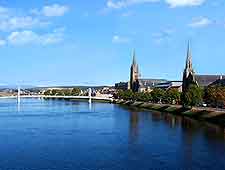
Inverness is many things, capital of the Scottish Highlands, a seaport at the northern mouth of Great Glen, a royal burgh and one of the oldest settlements in the UK. This lovely historic small city has a long and storied history with just enough tourist attractions to warrant a lengthy layover. There are plenty of great dining, drinking and shopping options in Inverness, spread either side of the shallow River Ness, although not as many cultural attractions as you would perhaps expect.
The city of Inverness is, however, an excellent base for exploring the wonders of the Highlands like Loch Ness, the Black Isle and Cawdor Castle. Pick up your tourist information at the Highlands of Scotland Tourist Board at Castle Wynd, just off the High Street, and you will be well on your way to a stellar cast of memorable adventures.
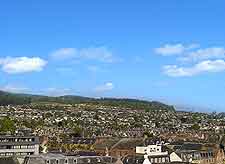
Inverness Tourist Information and Tourism: Top Sights
Whether you believe the hype or not, it would be a shame to come all the way to Inverness and not drive another half hour to witness the world wonder that is Loch Ness. The beast herself, nicknamed Nessie, probably won't make an appearance except in the form of kitschy cardboard cutout souvenirs and tartan cuddly monster toys. Many tourists on holiday in the Highlands of Scotland choose to rent a car and make a leisurely anti-clockwise drive along the shoreline road of Loch Ness, soaking in some of the nicest views in the region. More information about
Loch Ness.
Guide-led walking tours of the city are recommended when you first arrive, lasting just over an hour and departing from the tourist information office. There are also themed evening Ghost Tours and 'Churches along the River' tours, offering something a little different, as well as sightseeing buses and cruises on the Moray Firth, where it's not unheard of to spot the odd bottlenose dolphin or two. Other possibilities for tourists in Inverness include a walk alongside the Ness River and around the Ness Islands, connected by a number of footbridges from Victorian times.
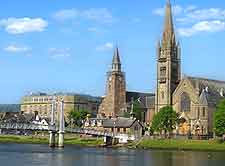
Just a short distance to the east of the city, the Culloden Battlefield is an important local spot, where in the middle of the 18th century, Bonnie Prince Charlie fought with his army and quickly lost to the Duke of Cumberland, with around 2,000 wounded or killed in just 40 minutes. Also nearby and again to the east, the circular Stone Age burial tombs of Clava Cairns (officially the Prehistoric Burial Cairns of Balnuaran of Clava) comprise three rings of intact stones, two with entrances aligned with the sun and leading to the centre. More information about
Inverness Tourist Attractions.
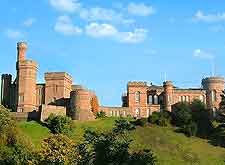
Being such an old city, thought to have been founded during the 12th century by King David, Inverness comes with many old and eye-catching landmarks to see, explore and take photos of, although with its periodic violent history, some of the oldest buildings have long been destroyed. The city's crowning glory is without question Inverness Castle, which was first built almost 900 years ago, although the castle has the Victorians to thank for it its present-day sandstone facade. Whilst the castle may today be off-limits, it is still worth a look, and a stroll around the lovely grounds is quite mandatory.
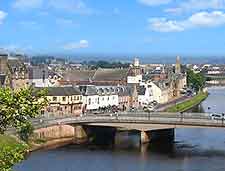
Presiding over the western banks of the Ness River, the Tomnahurich Hill (Hill of the Fairies / Hill of the Yews) offers excellent panoramas from its very top, suiting those feeling energetic and up for a scenic walk. Close to the Eden Court Theatre and the Northern Meeting Park, and just off the riverside Ness Walk, the Cathedral Church of Saint Andrew dates back to the late 1860s and is a Scottish Episcopal Church. Situated on Church Street, both Abertarff House and Old High Church are further landmarks of note. More information about
Inverness Landmarks and Monuments.
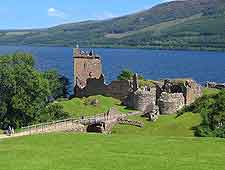
The history of the Scottish Highlands is recorded for all to see at the Inverness Museum and Art Gallery, where historic information, reconstructions, relics and dioramas are accompanied by some themed exhibitions of art. At the Highland Photo Archive, a huge collection of literally tens of thousands of photographs document the gradual evolution of Inverness, since the latter part of the 18th century. History buffs should pay a visit to Fort George and the Queen's Own Highlanders Regimental Museum, in neighbouring Ardersier, with its audio guides providing useful commentary as you explore this working fortress and its collections of medals, weaponry, uniforms and other Highlanders memorabilia. For quality Scottish handicrafts, original paintings and prints, tourists looking for souvenirs should head to the Art Gallery on The Green. More information about
Inverness Museums.
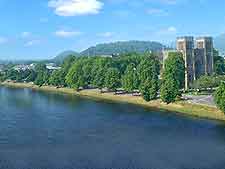
As one of the fastest-growing cities in the United Kingdom, Inverness is a good place for day trips into the Scottish Highlands and beyond, with the attractions of the Highlands (central, northern and western) being particularly tempting, along with those of the Great Glen and the Moray Firth coastline. On the westerly shore of Loch Ness, the 13th-century ruins of Urquhart Castle at Drumnadrochit provide the perfect spot for monster hunters, while Fort Augustus lies on the south-western side of the loch.
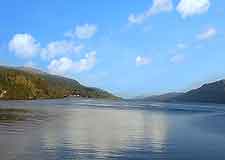
In the Nairn area, the National Trust of Scotland's Brodie Castle makes for a worthy excursion and is located to the north-east, with Cawdor Castle also lying in this direction, although closer to the city. Home of the Glen Affric National Nature Reserve, the valley of Strathglass is another day trip possibility, along with the magnificent Cairngorms National Park and its funicular railway, the endless recreational activities around the Nevis Range (Aonach Mor), and the charming villages of the Black Isle. More information about
Inverness Attractions Nearby.
More Inverness Information / Fast Facts and Orientation
- Country: Scotland (north)
- Location: Central Scottish Highlands / Great Glen / next to Grampian Mountains
- Status: city / capital of the Highlands of Scotland
- Area of Central and Western Highlands: approximately 3,725 square miles / 9,650 square kilometres
- Population: approximately 60,000
- Language: English / Scottish Gaelic
- Currency: Pound Sterling (GBP)
- Time zone: GMT / UTC and BST (British Summer Time), 5 hours from Eastern Standard Time
- Country dialling code: +44
- Telephone area code: 01463
- Average daily Inverness January temperature: 4°C / 39°F
- Average daily Inverness July temperature: 17°C / 63°F
 Inverness is many things, capital of the Scottish Highlands, a seaport at the northern mouth of Great Glen, a royal burgh and one of the oldest settlements in the UK. This lovely historic small city has a long and storied history with just enough tourist attractions to warrant a lengthy layover. There are plenty of great dining, drinking and shopping options in Inverness, spread either side of the shallow River Ness, although not as many cultural attractions as you would perhaps expect.
Inverness is many things, capital of the Scottish Highlands, a seaport at the northern mouth of Great Glen, a royal burgh and one of the oldest settlements in the UK. This lovely historic small city has a long and storied history with just enough tourist attractions to warrant a lengthy layover. There are plenty of great dining, drinking and shopping options in Inverness, spread either side of the shallow River Ness, although not as many cultural attractions as you would perhaps expect.
 Just a short distance to the east of the city, the Culloden Battlefield is an important local spot, where in the middle of the 18th century, Bonnie Prince Charlie fought with his army and quickly lost to the Duke of Cumberland, with around 2,000 wounded or killed in just 40 minutes. Also nearby and again to the east, the circular Stone Age burial tombs of Clava Cairns (officially the Prehistoric Burial Cairns of Balnuaran of Clava) comprise three rings of intact stones, two with entrances aligned with the sun and leading to the centre. More information about Inverness Tourist Attractions.
Just a short distance to the east of the city, the Culloden Battlefield is an important local spot, where in the middle of the 18th century, Bonnie Prince Charlie fought with his army and quickly lost to the Duke of Cumberland, with around 2,000 wounded or killed in just 40 minutes. Also nearby and again to the east, the circular Stone Age burial tombs of Clava Cairns (officially the Prehistoric Burial Cairns of Balnuaran of Clava) comprise three rings of intact stones, two with entrances aligned with the sun and leading to the centre. More information about Inverness Tourist Attractions. Being such an old city, thought to have been founded during the 12th century by King David, Inverness comes with many old and eye-catching landmarks to see, explore and take photos of, although with its periodic violent history, some of the oldest buildings have long been destroyed. The city's crowning glory is without question Inverness Castle, which was first built almost 900 years ago, although the castle has the Victorians to thank for it its present-day sandstone facade. Whilst the castle may today be off-limits, it is still worth a look, and a stroll around the lovely grounds is quite mandatory.
Being such an old city, thought to have been founded during the 12th century by King David, Inverness comes with many old and eye-catching landmarks to see, explore and take photos of, although with its periodic violent history, some of the oldest buildings have long been destroyed. The city's crowning glory is without question Inverness Castle, which was first built almost 900 years ago, although the castle has the Victorians to thank for it its present-day sandstone facade. Whilst the castle may today be off-limits, it is still worth a look, and a stroll around the lovely grounds is quite mandatory. Presiding over the western banks of the Ness River, the Tomnahurich Hill (Hill of the Fairies / Hill of the Yews) offers excellent panoramas from its very top, suiting those feeling energetic and up for a scenic walk. Close to the Eden Court Theatre and the Northern Meeting Park, and just off the riverside Ness Walk, the Cathedral Church of Saint Andrew dates back to the late 1860s and is a Scottish Episcopal Church. Situated on Church Street, both Abertarff House and Old High Church are further landmarks of note. More information about Inverness Landmarks and Monuments.
Presiding over the western banks of the Ness River, the Tomnahurich Hill (Hill of the Fairies / Hill of the Yews) offers excellent panoramas from its very top, suiting those feeling energetic and up for a scenic walk. Close to the Eden Court Theatre and the Northern Meeting Park, and just off the riverside Ness Walk, the Cathedral Church of Saint Andrew dates back to the late 1860s and is a Scottish Episcopal Church. Situated on Church Street, both Abertarff House and Old High Church are further landmarks of note. More information about Inverness Landmarks and Monuments. The history of the Scottish Highlands is recorded for all to see at the Inverness Museum and Art Gallery, where historic information, reconstructions, relics and dioramas are accompanied by some themed exhibitions of art. At the Highland Photo Archive, a huge collection of literally tens of thousands of photographs document the gradual evolution of Inverness, since the latter part of the 18th century. History buffs should pay a visit to Fort George and the Queen's Own Highlanders Regimental Museum, in neighbouring Ardersier, with its audio guides providing useful commentary as you explore this working fortress and its collections of medals, weaponry, uniforms and other Highlanders memorabilia. For quality Scottish handicrafts, original paintings and prints, tourists looking for souvenirs should head to the Art Gallery on The Green. More information about Inverness Museums.
The history of the Scottish Highlands is recorded for all to see at the Inverness Museum and Art Gallery, where historic information, reconstructions, relics and dioramas are accompanied by some themed exhibitions of art. At the Highland Photo Archive, a huge collection of literally tens of thousands of photographs document the gradual evolution of Inverness, since the latter part of the 18th century. History buffs should pay a visit to Fort George and the Queen's Own Highlanders Regimental Museum, in neighbouring Ardersier, with its audio guides providing useful commentary as you explore this working fortress and its collections of medals, weaponry, uniforms and other Highlanders memorabilia. For quality Scottish handicrafts, original paintings and prints, tourists looking for souvenirs should head to the Art Gallery on The Green. More information about Inverness Museums. As one of the fastest-growing cities in the United Kingdom, Inverness is a good place for day trips into the Scottish Highlands and beyond, with the attractions of the Highlands (central, northern and western) being particularly tempting, along with those of the Great Glen and the Moray Firth coastline. On the westerly shore of Loch Ness, the 13th-century ruins of Urquhart Castle at Drumnadrochit provide the perfect spot for monster hunters, while Fort Augustus lies on the south-western side of the loch.
As one of the fastest-growing cities in the United Kingdom, Inverness is a good place for day trips into the Scottish Highlands and beyond, with the attractions of the Highlands (central, northern and western) being particularly tempting, along with those of the Great Glen and the Moray Firth coastline. On the westerly shore of Loch Ness, the 13th-century ruins of Urquhart Castle at Drumnadrochit provide the perfect spot for monster hunters, while Fort Augustus lies on the south-western side of the loch. In the Nairn area, the National Trust of Scotland's Brodie Castle makes for a worthy excursion and is located to the north-east, with Cawdor Castle also lying in this direction, although closer to the city. Home of the Glen Affric National Nature Reserve, the valley of Strathglass is another day trip possibility, along with the magnificent Cairngorms National Park and its funicular railway, the endless recreational activities around the Nevis Range (Aonach Mor), and the charming villages of the Black Isle. More information about Inverness Attractions Nearby.
In the Nairn area, the National Trust of Scotland's Brodie Castle makes for a worthy excursion and is located to the north-east, with Cawdor Castle also lying in this direction, although closer to the city. Home of the Glen Affric National Nature Reserve, the valley of Strathglass is another day trip possibility, along with the magnificent Cairngorms National Park and its funicular railway, the endless recreational activities around the Nevis Range (Aonach Mor), and the charming villages of the Black Isle. More information about Inverness Attractions Nearby.